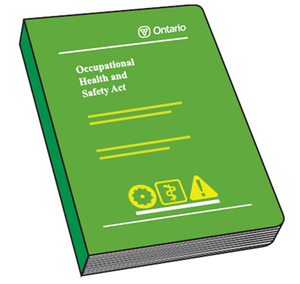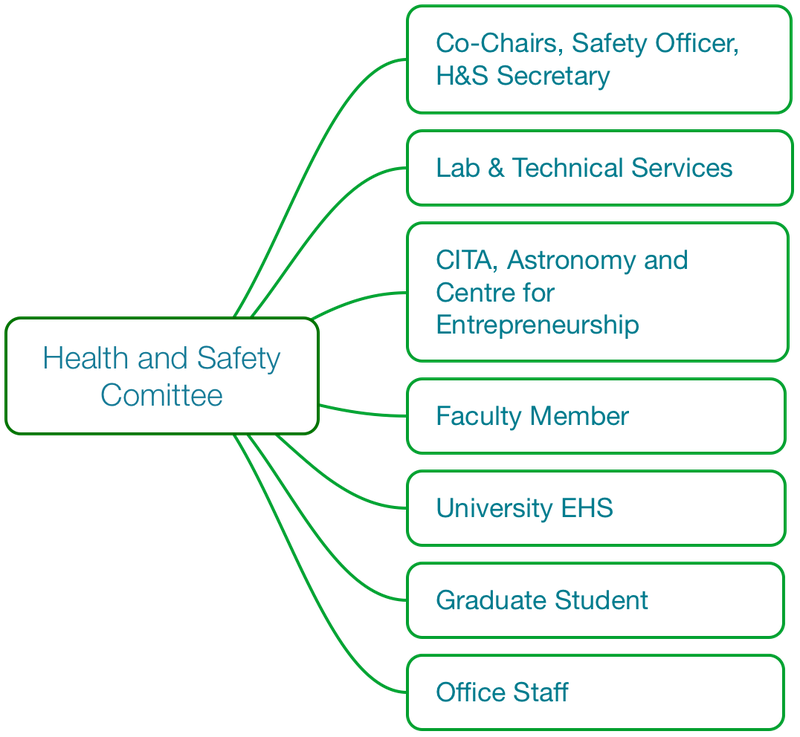Its purpose is to protect all employees (academic, technical and administrative staff) by outlining the legal responsibilities of both the employer and employee to identify and resolve safety concerns. This internal responsibility system involves all employees from the President and Governing Council to the individual worker. Supervisors and workers should be familiar with the main provisions of the Act and the regulations which apply to their workplaces.
2.1. Duties and Responsibilities
Each employee (full-time or part-time, unionized or non-unionized, management or non-management) shares some responsibility for health and safety at the University.
The primary responsibility lies with supervisors who have both a legal and administrative responsibility for managing the workplaces.
Supervisor’s Responsibilities
A supervisor is anyone who has either charge of a workplace or authority over a worker. This includes academic chairs, faculty members and principal investigators as well as administrative staff and management personnel. Supervisors have a legal duty to take every precaution reasonable in the circumstances to protect workers. Moreover, the Act sets up many specific responsibilities in the employer’s workplace concerning designated toxic substances, hazardous machinery, worker education, materials and use of personal protective equipment.

Supervisors are required to:
- Know the Act and the University's health and safety policies covering your workplace
- Inform you about potential or actual safety hazards in the workplace and train you on how to protect yourself from these hazards.
- Ensure that equipment, materials and protective devices required by regulation are provided to you and proper workplace procedures are implemented.
- Make sure all hazardous material in the workplace are properly identified and labeled through WHMIS legislation.
- Ensure that chemical safety information is readily available from Material Safety Data Sheets
Worker’s Responsibilities
A worker is a person who is paid to perform work or supply services. All University employees are classified as workers. This includes unionized teaching assistants or part -time summer employees.
Worker must:
- Work safely in compliance with the provisions of the Occupational Health and Safety Act and University policies by wearing protective equipment and clothing that the employer requires and not disabling safe measures / apparatus.
- Report to your supervisor defects or other safety hazards that might endanger you or another worker.
- Not use any material or operate any equipment that may result in injury to you or fellow workers.
- Report any accidents or injuries promptly to your supervisor.
Students
The University is committed to a safe and healthful place to work and study. Students are to be afforded the same protection that would be given a worker under the Act.
2.2. McLennan Health & Safety Committee
The University of Toronto as an employer is responsible under the Occupational Health and Safety Act for establishing and maintaining joint health and safety committees.
Role of the Health & Safety Committee
- Identify workplace hazards concerning equipment, substances, experimental processes, working conditions, operating procedures or anything that could result in personal injury.
- Make recommendations to management and monitor any corrective action.
- Obtain H &S information from the employer regarding any workplace testing for health and safety purposes
- Meet at least once every three months and copies of minutes made available in the H & S Office or posted on safety bulletin board.
- Conduct yearly workplace inspections and notify occupants of any violations.
- Investigate and report all serious accidents.
Committee Structure
The McLennan Health & Safety Committee consists of representatives from various groups within the McLennan Physical Laboratories including unionized and non-unionized employees, graduate students, Principal Investigators and managers. Certified members on the Committee undergo health and safety training based on WSIB course standards.
McLennan Health & Safety Organizational Structure

The following academic, technical and administrative members and their contact information can be found: posted on the safety bulletin boards located by MP306, MP062, MP137, and across from MP257, or by asking at the Health and Safety Office in MP302, or listed on the Health & Safety site: Health and Safety
Health & Safety Committee Members
| NAME | ROOM | PHONE | |
|---|---|---|---|
|
Robin Marjoribanks
|
1104C |
978-6769
|
marj@physics.utoronto.ca
|
| Rob Henderson | 072 | 978-8510 | hender@physics.utoronto.ca |
| Peter Hurley | 327 | 978-1726 | peterh@physics.utoronto.ca |
|
Candace Duong
|
1212B | 978-6879 | citadmin@cita.utoronto.ca |
| Phil Scolieri | 128 | 978-2957 | scolieri@physics.utoronto.ca |
| Jo-Anne Wurster | 302 | 978-2231 | joanne.wurster@utoronto.ca |
|
Gregory Wu
|
805A |
978-6452
|
gwu@physics.utoronto.ca
|
|
Kaley Walker
|
712 |
978-8218
|
kwalker@atmosp.physics.utoronto.ca
|
|
Zora Anaya
|
|
978-3149
|
z.anaya@utoronto.ca
|
|
Arman Molki
|
070B
|
978-0626
|
arman.molki@utoronto.ca
|
|
Abdullah Parekh
|
EHS
|
978-3148
|
a.parekh@utoronto.ca
|
|
Christine Weidner
|
EHS
|
|
c.weidner@utoronto.ca
|
| Paul Woitalla |
067E
|
978-3533 | woitalla@physics.utoronto.ca |
|
|
|
|
|
|
|
|
|
2.3. Workers Rights under the Act
- Right to participate in the identification and resolution of workplace safety concerns individually or through representation on the local health and safety committee.
- Right to refuse work that they believe is dangerous to either their own health and safety or that of a fellow employee.
- Right to know about potential hazards which they may be exposed to and the guarantee of appropriate training and safety materials through legislation such as the Workplace Hazardous Material Information System (WHMIS) for hazardous chemicals
* Certified Health and Safety members can stop work that is dangerous to any worker. The Act outline these circumstances and how the work stoppage is to proceed.
2.4. Resolving Health & Safety Concerns
If you have a health and safety concern,
- Inform your supervisor.
Your supervisor will work with you to resolve your concern. - Refer the issue to the Joint Health and Safety Committee.
The committee can look into the matter and make recommendations for resolution. - At any time, employees can refuse to conduct any unsafe work. Your supervisor is then required to follow the procedures outlined under the OH+S Act.
